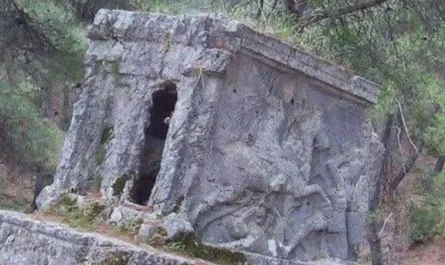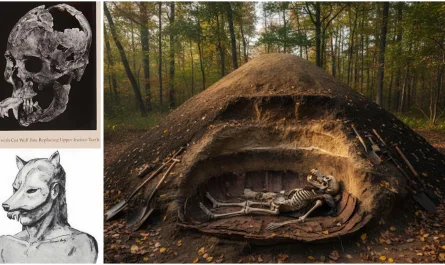The True Story of Charles Hudspeth and America’s Forgotten Miscarriage of Justice
In 1892, a man named Charles Hudspeth was executed in Harrison, Arkansas, for the murder of George Buchanan — a man who wasn’t dead. Months later, the supposed victim reappeared alive. This haunting true story exposes one of the most devastating failures of justice in American history.

A Winter Morning and a Wooden Scaffold
The morning of December 30, 1892, dawned gray and cold in the small Ozark town of Harrison, Arkansas.
Frost clung to the gallows like a ghostly veil. The crowd gathered early — townsfolk, reporters, even children, their breaths forming small white clouds in the frozen air.
They came to see the hanging of Charles Hudspeth, a man accused of killing his lover’s husband.
A man whose trial had divided the town for years.
A man who never stopped proclaiming his innocence.
“Do you have any last words, Mr. Hudspeth?” asked the sheriff.
Hudspeth’s hands trembled slightly, not from fear but from the biting cold. His voice, however, was clear and steady.
“Gentlemen, I stand before you an innocent man. God knows I did not kill George Buchanan. The truth will come out — even if I’m not here to see it.”
Moments later, the trapdoor fell open.
The rope snapped taut.
And just like that, justice — or what passed for it — was done.
But history would not let this story rest in peace.
The Love That Sparked a Scandal
To understand how Charles Hudspeth came to the gallows, we must return to the heart of a scandal that began years earlier, in 1886.
Hudspeth was no outlaw. Born in rural Arkansas, he was a quiet, hardworking man, known for his reliability and kindness. But he had one fatal weakness — Rebecca Buchanan.
Rebecca was described in contemporary papers as “a woman of uncommon beauty and restless heart.” She was married to George Buchanan, a blacksmith, by all accounts a decent man, though temperamental and prone to jealousy.
In the small, gossip-fueled world of Harrison, even casual friendships were dangerous. When Charles began visiting the Buchanans’ home, helping Rebecca with chores while George was away, whispers began.
By autumn, those whispers turned to accusations.
Neighbors claimed to have seen Charles and Rebecca walking together late at night, their heads close, their laughter too intimate. Others said they’d overheard talk of “getting rid of George.”
Hudspeth dismissed it all. “It’s talk,” he told a friend at the time. “People will say what they will.”
But the talk would soon lead to something far darker.
The Disappearance of George Buchanan
On a spring morning in 1887, George Buchanan was gone.
Rebecca told neighbors he had left to find work in the west — perhaps Kansas or Texas. “He’s done it before,” she insisted. “He’ll be back when he’s ready.”
But weeks passed. Then months. And George never returned.
The absence became fuel for gossip. Some said George had abandoned Rebecca. Others whispered that she and Charles had done something terrible.
Then came the discovery that sealed Hudspeth’s fate.
The Body Without a Name
In late 1888, two hunters near Crooked Creek, a few miles outside Harrison, stumbled upon a badly decomposed, headless body half-buried in the brush. The remains were nearly unrecognizable — only scraps of clothing and a few bones.
But to the townspeople, that was enough.
The tattered remnants of a shirt “similar to one George owned,” and the fact that he’d been missing for over a year, convinced everyone the corpse was his.
It didn’t matter that no head was found. It didn’t matter that no forensic tests existed.
People wanted an ending — and Charles Hudspeth was the perfect villain.
A Confession That Never Was
Rebecca Buchanan was soon brought in for questioning.
She was nervous, evasive, and overwhelmed by suspicion.
Under intense pressure — and possibly the threat of being charged herself — she broke down and gave the statement that would doom Hudspeth.
She told the sheriff that Charles had confessed to killing George.
That he’d struck him over the head with an axe, dismembered the body, and buried it in the woods.
She claimed she had helped hide the evidence.
No physical proof. No eyewitnesses.
Just her word.
In the public’s eyes, that was enough. A crime of passion, they said — the classic tale of lust and jealousy. The community, outraged and scandalized, demanded justice.
The Trial of the Century (For Harrison, Arkansas)
The trial began in May 1887 and drew crowds from surrounding counties. Local newspapers called it “the most sensational proceeding ever held in Boone County.”
Hudspeth sat quietly through the testimony, shaking his head as Rebecca described the alleged murder.
He denied every word.
“I never harmed George Buchanan,” he told the court. “He was my friend.”
But the jury was not inclined to mercy.
Rebecca’s emotional performance, combined with the moral outrage of the town, sealed his fate.
The verdict: Guilty of murder in the first degree.
Years of Appeals and Desperation
Hudspeth’s lawyers appealed the conviction several times, arguing that there was no evidence George Buchanan was even dead. But the courts upheld the verdict.
For five long years, Charles sat in a cell in Little Rock, awaiting execution.
He read the Bible, wrote letters proclaiming his innocence, and begged the governor for clemency.
One witness later recalled that he spent his days carving small wooden crosses, giving them to other inmates “so they’d remember him when the truth came out.”
In December 1892, his final appeal was denied.
He was transported back to Harrison for his execution.
The Hanging
The hanging took place behind the courthouse.
An estimated 300 people came to watch — men, women, even children perched on fences for a better view.
The Arkansas Gazette reported that Hudspeth “faced death with composure,” and that he “protested his innocence in solemn tones that moved many to tears.”
Rebecca Buchanan was not present.
After the trial, she’d left town, reportedly living under another name in Missouri.
The execution was swift.
By noon, the body was cut down and placed in a pine coffin.
No priest. No ceremony. Only silence.
The Dead Man Who Walked Into a Saloon
Months passed. Then, one warm evening in Kansas, a man walked into a saloon.
The bartender froze — the man looked familiar. Weathered, bearded, older perhaps, but unmistakably George Buchanan.
He ordered a whiskey and struck up conversation, saying he’d come from Arkansas years ago.
When pressed, he admitted that yes, he’d left his wife suddenly after an argument, and had been working odd jobs ever since.
Word spread quickly — faster than a telegraph could click.
A local sheriff compared old descriptions, confirmed his identity, and sent a report to Arkansas.
The man Charles Hudspeth had been executed for killing… was alive.
Shock, Shame, and Silence
The news hit Harrison like a thunderclap.
The Harrison Times published a short, uneasy notice:
“Reports have reached this office that George Buchanan, whose supposed murder led to the execution of Charles Hudspeth, is alive in Kansas. We await official confirmation.”
When confirmation arrived, outrage followed — but only briefly.
There was no retrial, no inquiry, no punishment.
No apology from the governor.
The state simply buried the story.
Rebecca Buchanan vanished completely from public life. Some said she fled to Texas; others claimed she died of illness a few years later. Her grave was never found.
Hudspeth’s remains were buried in a small, unmarked plot on the edge of town — forgotten by nearly everyone except a few horrified journalists and a handful of reformers.
The Aftermath and the Movement
In the years that followed, Hudspeth’s name appeared in legal journals and reform pamphlets as a tragic example of capital punishment gone wrong.
A 1901 publication by the American Anti–Death Penalty League cited the case directly:
“The execution of Charles Hudspeth in Arkansas stands as a dreadful warning. No human system of law can be infallible. Once the rope tightens, there is no undoing it.”
His case helped fuel early discussions on due process, evidentiary standards, and the moral weight of irreversible punishment.
By the early 20th century, the name “Hudspeth” became shorthand among legal scholars for a fatal miscarriage of justice — though the man himself had long since faded into dust.
Forgotten by Time, Remembered by History
Today, the site of the old gallows in Harrison is long gone.
A parking lot and municipal building now stand where the crowd once gathered.
No marker honors Hudspeth’s memory.
Yet his story survives in the archives — a whisper from a time when the law moved too swiftly and proof meant little more than rumor.
If you listen closely, you can still hear the echo of his final words:
“I am innocent. I never killed that man.”
Legacy and Reflection
Charles Hudspeth’s execution stands as one of the earliest proven wrongful deaths by execution in U.S. history.
It exposed the fragility of justice built on emotion, gossip, and circumstantial evidence.
Every modern exoneration, every DNA-based reversal, every legal safeguard — owes something to the ghosts of cases like his.
Because his story is not just about a single man.
It’s about what happens when truth arrives too late.
🪦 Epilogue
No one knows where exactly Charles Hudspeth lies buried.
But his name endures as a quiet protest against haste, hysteria, and human error.
And somewhere, deep in the folds of history, his story still asks a question that justice can never fully answer:
“If the law can hang an innocent man once… what’s to stop it from doing so again?”
Tags: #TrueCrime #History #DeathPenalty #WrongfulExecution #AmericanJustice #ArkansasHistory #HudspethCase





